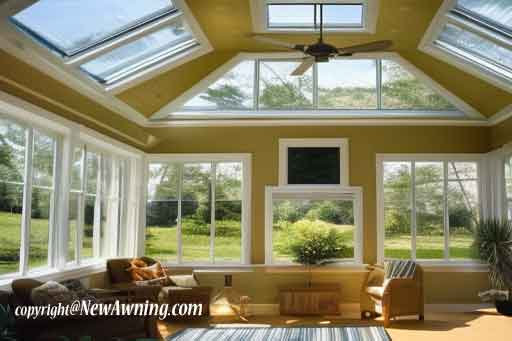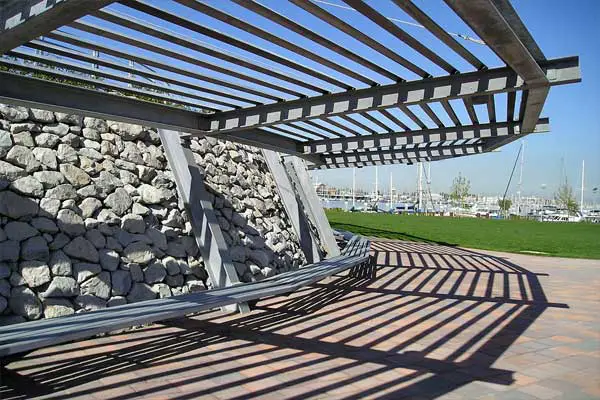Last Updated:July 02, 2025
Guide to Adding Solar Panels to Sunroom

A sunroom is a small room, often on the ground floor of a home, that is designed to be used as an additional living area. Sunrooms are popular in climates with cold winters because they provide warmth and sunshine all year round. The most common type of sunroom has windows facing south or west for maximum exposure to sunlight. A sunroom can also be created by placing glass panels near the roof line to capture light from above.
Because of their location, the roof of a sunroom is a terrific place to install solar panels. A large 20’x20′ sunroom could hold enough panels to generate 6000 watts of power. Even a small 11’x12′ sunroom 1980 watts which is to cut into a monthly electric bill.
These panels will not reduce the amount of natural light coming into your home, and you lower your overall electricity bill. If you’re considering adding solar panels to your roof, this article explores how much energy you could potentially save by installing them on your existing sunroom.
Interviewing the installation companies
Before you install solar panels on your sunroom or any other part of your roof, I recommend speaking with a few reps to get quotes. They will be able to give you options, and help you determine how many panels you need.
They will also be able to look at your specific address to get an estimate of how much sunlight you will receive each year. We live in central Arizona so solar panels for us would generate much more energy than if we were to live in a Chicago or Seattle.
The local company will be able to give you an estimate. I always like talking to multiple companies because I’ve found their estimates can be wildly different. Also, note they want the system to seem to produce the highest possible ROI so take this in consideration when viewing their data.
When there is gray area as to the estimate, you can assume they are leaning towards the options that will make their offer as enticing as possible.
Another perk of speaking with installation companies is that they will be able to tell you of any tax credits that would be available. Additionally, some electrical companies offer incentives to get people to switch to solar. This may seem counter intuitive, but if your system is plugged into the grid, you are supplying energy to the grid. This will help even out the load for the electrical companies since the highest usage times are during the workday when the sun is at it’s brightest.
Buy or lease Solar Panels
Consumer reports had an amazing article a few years back explaining solar panels and the various finance options. It’s 5 years old, but it’s so good that we’ve included a link to their article if you want to check it out.
Cash – The best option if you have access to the money is to pay for the project with cash. This will give you the absolute most options as to what companies to work with. You will also avoid any loan origination fees, and you will be able to claim 100% of the credits from your power company.
Furthermore, depending how you file taxes, you may be able to deduct the full amount of the project from your adjusted gross income. On top of that, you may qualify for further tax credits beyond what you paid for the system through some local or state programs.
A typical solar installation on a home can be between $15,000 to $20,000 for a 2000 square foot home.
Mortgage refinance – Mortgage rates are 2.64% as I’m writing this article, and this is a historically low rate. If you have equity in your home, you may be able to refinance the home to a lower rate and take out enough cash to cover the cost of the solar power installation. This is an ideal option because you are effective financing the solar panels over 30 years while getting all the tax perks right now.
Also, mortgage interest is deductible for many homeowners allowing you to increase your savings even further. This requires you to have good credit and equity in your home. Also, note the origination fee for the mortgage is going to be around 1% of the total loan value so if you are refinancing $300,000, you can expect the origination fee to be $3,000.
If you are only using the refinance to cover the solar panels this this option doesn’t make sense. It is effectively a 15% surcharge on a $20,000 installation.
We only suggest a refinance if you will save money by lowering your overall interest rate. For us, we were able to refinance from 4.25% to a 2.75% mortgage rate that saves us several hundred dollars each month.
Home Equity Line of Credit – If you don’t have the equity in your home or a rate that make sense for a total refinance a Home Equity Line of Credit (HELOC) can be a fantastic option.
A HELOC is a loan where you only take out the money you need. Many banks offer a HELOC with no origination fees and those that do will normally be around $500.
HELOC rates are for a shorter time often around the 10 year mark, and they have slightly higher rates than a full refinance. Right now, HELOC rates are around 3.6% so you are paying about 1% more per year for the money, but it is a much smaller loan amount.
Also, the premise of adding solar is that your electric bill should decrease by a larger amount than the cost of the loan. Every system will be different, but you should expect to pay the loan back from the electrical savings in 7-8 years.
Solar Loans – Solar loans are offered by installers. They are very convenient in that you just sign a contract while they are in your home, and they handle all the financing for you. Some solar installers may even push you towards this way of paying for the panels.
These are unsecured loans, and they have the highest interest rate. Solar loans range from 5% to 35%. Yes, that is not a typo, solar loans can go up to 35% interest per year making them nearly impossible to ever fully pay off.
Even under the best case scenario, the lowest solar loan quote we were able to find was 5% which is about 50% higher than going with a HELOC through your local bank.
Another drawback to solar loans is that they may have other riders like increasing surcharges each year. I would never under any circumstances sign up for a solar loan for this project. There are simply much cheaper ways of getting the money for solar panels.
As I mentioned before some solar companies will only want to work with you if you finance through them. The reason is this allows them to bury fees in the paperwork and you are talking in monthly payment amounts rather than a total cost structure.
Leasing Solar Panels – In our opinion, leasing solar panels is the absolute worst option. When you lease the solar panels, are are technically not buying and installing them on your roof. Until the conclusion of the lease, they are still technical owned by the solar company.
This may give the company the ability to control how many panels you will have. They may be the ones who get the rebates from the electrical companies, and leased solar panels won’t get nearly the tax benefits of ones that you purchase and install on your own.
One of their pitch points for leased solar panels is that the company will be responsible for maintenance; however, as one solar engineer shared this is mainly marketing hype.
This was explained in detail by Joshua Pearce, an engineering professor in Michigan. He said, if there is an equipment problem with the panel, it will go to the manufacturer as a warranty claim. If there’s damage due to storms, fire or other, it will go to your homeowner insurance policy that the homeowner is require to pay.
Ironically adding solar panels may even drive up the cost of your home owners insurance policy so you are paying extra to insure the panels for the “all-inclusive service plan”.
Choosing the right company
While we have a lot of DIYers on our site, we do not recommend adding solar panels as a DIY project. There are several reasons for this.
State and Local Building Codes – Solar panel installations must meet the appropriate building codes. Quite frankly, this is a more complicated than the average home DIYer is going to be comfortable.
Solar Panels Get Equipment Wholesale – This doesn’t mean they will be passing along the savings to you, but it does mean that even with their markup they may be able to sell you the panels at a cheaper price than you’d pay going through an Amazon, Lowe’s or Home Depot.
Improper Installation May Lead to Fires – You are dealing with live electrical circuits and remember the panels will be exposed to elements. A system that seems to work perfectly on a warm summer day for the installation may have significant issues in a hail storm or under the weight of winter snow.
DIY installations may void home insurance claims – I’ve seen this a lot with DIY awnings where the homeowner buys a kit and installs it without any necessary permits. All is going well until an accident happens, and the insurance company refuses to pay a claim due to the to unapproved modification to the home.
Difficult or Impossible to sell the home – Most prospective buyers will want a home inspection, and they will want to know details of the solar panel installation. Rather than signing off on the installation, they may require a separate evaluation of the solar panel which could result in costly work orders.
Prospective buyers are obviously going to pay less for a home if they signup to take ownership of the problem that they’ll then have to fix later. And in some cases, it may not even be possible to sell the home until the electrical system is brought upto code.
Solar Panels could violate local or HOA regulations – Some areas have prohibited the installation of solar panels. This isn’t something the average homeowner will know how to research, and they may be unaware until they get a violate letter.
I wrote in another post about a family who added a mini-split AC unit to their home without getting approval. This was a violation of the HOA rules as the outside unit impacted the external appearance of the home. This was eventually settled, but only after lawyers got involved on both sides.
Working with a general contractor when building a sunroom
If you are building a new sunroom, you can work with your general contractor to put the solar panel installation as part of the overall project. This way they are helping you pick the vendor and working with the electricians to getting everything up to code.
This can also be a far cheaper way to add solar to the sunroom as the solar panels installation will be a known task when the roof is going in. Also, the necessary wiring to support the extra load can be planned for as the walls are being put up.
If you are serious about adding solar to your sunroom, I recommend having this as one of the screening criteria when hiring a general contractor. Many of them are very familiar with solar projects, and this is a great way to get a quality install without worrying that you are being taken advantageous of by working directly with a solar company.
Wrapping Up
That completes our guide to adding solar panels to your sunroom. I hope you find it helpful as you’re looking to hire someone to install the panels for you.
If you’ve recently added a sunroom, we’d love to hear from you. Were you considering adding solar panels? If so, did you decide for against the installation? How did it turn out for you?
Also, do you have any tips you’d like to share with our other readers?
Finally, we’ve written a complete guide to sunrooms if you’d like to check it out.



